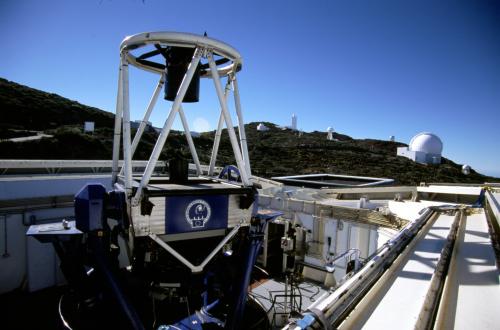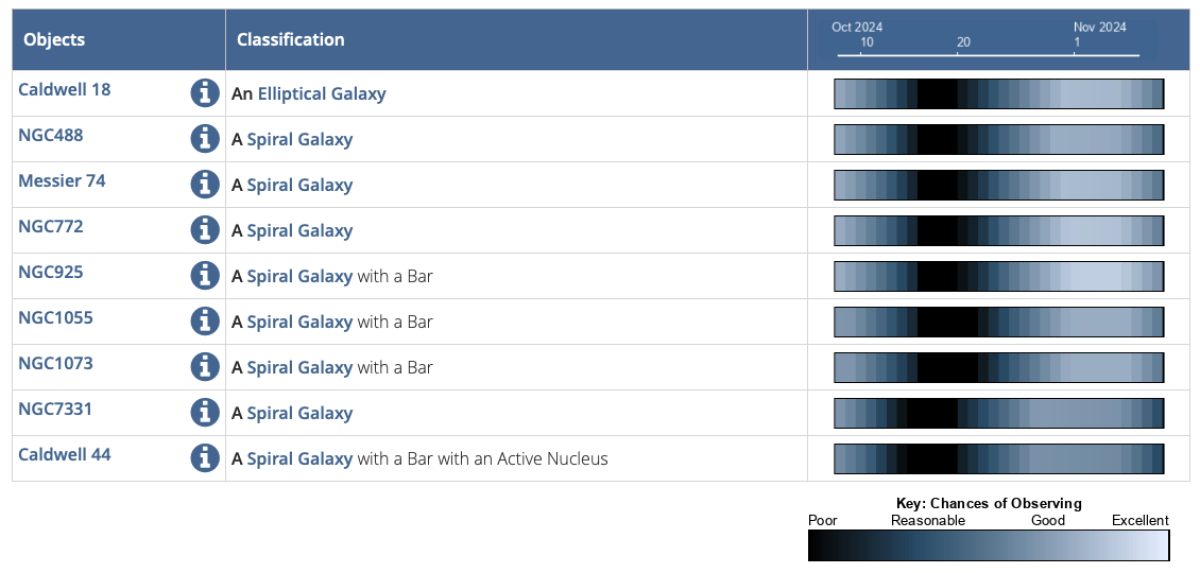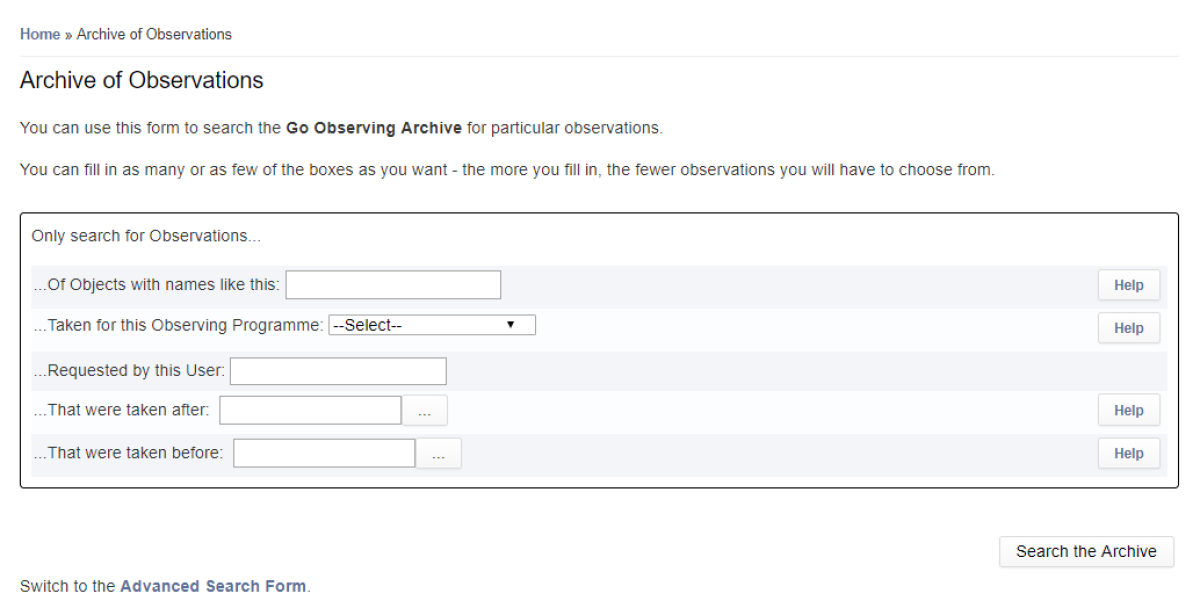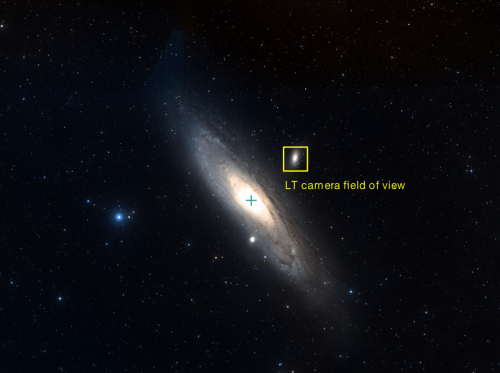Go Observing is at the centre of The Schools' Observatory - the system guides you through choosing observations, checking on their progress, and downloading the data when it is ready.
A lot happens "behind the scenes" to make this as smooth as possible.
This page talks more about the system to help you understand enough about how it works to make good use of it:
- What does Go Observing do?
- Image
 CreditThis work by Liverpool Telescope is licensed under Creative Commons Attribution Non Commercial Share Alike 4.0 International
CreditThis work by Liverpool Telescope is licensed under Creative Commons Attribution Non Commercial Share Alike 4.0 InternationalThe Liverpool Telescope Go Observing is there to help you take images with the telescopes without getting lost in the details.
We created this because using a professional telescope can be a tricky process. Many steps are involved, from choosing the right objects to deciding on the instrument, filter and exposure time. All the way to the final submission to a telescope.
Go Observing has been designed to hide all the unnecessary details and leave just the important and interesting decisions. Of course, these will depend on what you hope to do, so the system is very flexible. It changes to match the user's age group and guides you through the process with a set of questions and simple choices.
The aim is to make sure you have good options to choose from without being disappointed due to poor choices of object, filter, exposure time, etc.
Once you have made your choice, Go Observing will turn it into a form that a telescope can understand, send out the request, monitor what is happening, and keep you updated.
- How long will my observations take?
There are many things that determine how long you may have to wait. Some of these we can predict, like how long in the night an object can be seen, what the Moon's phase is, or when a moon of Jupiter finishes a full orbit.
These things are included when Go Observing calculates the "visibility" colour bars you see when choosing an object to look at.
Image CreditThis work by The Schools' Observatory is licensed under All rights reserved
CreditThis work by The Schools' Observatory is licensed under All rights reserved"Visibility" colour bars for some galaxies Other factors, such as weather, are not predictable. If the weather is fine, observations with "excellent" or "good" chances of being observed will usually be done the same night they are requested. And because the telescopes you can access are all around the world, you might not even have to wait until it gets dark where you live! When it's daytime for you, it's the middle of the night somewhere else, and a telescope working there could take your request.
However, some nights, the telescopes are busier than others, so you may have to wait a night or 2.
Another thing to consider is the size of the telescope needed to complete your request. There are many more 1-metre and 0.4-metre telescopes on the Las Cumbres Observatory network, so requests sent to these will usually be made more quickly than on our 2-metre telescopes.
We keep a close eye on the time taken for you to get your observations and sometimes "tweak" the system to make sure it is always running as efficiently as possible.
- Are there any backups if my observation is not done in time?
Yes. All observations taken since the project began in 2004 are available from our Archive.
Image CreditThis work by The Schools' Observatory is licensed under All rights reserved
CreditThis work by The Schools' Observatory is licensed under All rights reservedGo Observing Archive seach form For about 3 months after they are taken, only the person who asked for the image can access the data, but after that, all observations are available to everyone registered.
You can search through the archive in many different ways, for example, by object name or the kind of Observing Programme. There is also an "Advanced Search Form" for even more detailed searches.
So, if you are unlucky with the weather and do not have the observations you want for a lesson or just want to explore, the archive can get you data quickly and easily.
- Are there any limits to the number of requests?
No, there are no limits to the number of requests you can make. There are 2 reasons why we can do this without overloading the telescopes:
- The Go Observing system is not wholly open. This means there is an automatic limit to the total number of requests which can be made for 1 night (although this limit is huge).
- Suppose identical requests are made by more than one user at the same time. In that case, only 1 observation is taken and given to both users. This is never done retrospectively, though. If you ask for an observation of Jupiter a couple minutes after one was already taken, another will be taken just for you.
This is similar to the system for professional astronomers and helps get observations back to people with the smallest delay possible. It is much quicker, for example, to take one observation of Saturn and give it to 50 people than take 50 separate observations!
- Can I choose to observe anything?
No, not quite. As mentioned above, observing is complicated, and mistakes can easily be made. We have decided to limit the choice of objects to those we know will give sensible results.
For example, many people would like to observe the Andromeda galaxy. However, this is much bigger than the field of view of the telescope instruments. In fact, if we use the Liverpool Telescope as an example, Andromeda is thousands of times the size of the field of view of the main camera!
Image CreditThis work by Sloan Digital Sky Survey/The Schools' Observatory is licensed under Creative Commons Attribution 4.0 International
CreditThis work by Sloan Digital Sky Survey/The Schools' Observatory is licensed under Creative Commons Attribution 4.0 InternationalAndromeda galaxy with the Liverpool Telescope's field-of-view (added by The Schools' Observatory) shown in yellow We have narrowed a database of over 20,000 galaxies to a few hundred that we know will create good results. From these, Go Observing will select the handful that are best at a particular time for you to choose between. We also change and add new objects as time passes, so the choices constantly evolve.
In this way, we make sure that people are not disappointed with their observations, which can be discouraging. However, this sometimes means your favourite object is not on the list.
If you have a special selection or want to see new objects included, please email us at SchoolsObs@ljmu.ac.uk, and we can see if this is possible.
- Does everybody have the same choices?
Not quite. A strength of Go Observing is that it can adjust to the type and age of the user. A primary school child usually has different interests than a post-16 physics student.
Also, a Teacher account sees a wider range of observing programmes than a Student account. Because of this, teachers can happily let their students work on their own and not worry about them getting lost or overloaded with too many choices.
Teachers can set up entire class sets of usernames using the Create Students tools in the "My Account" menu.
- Why can't I find one of my old observations?
You can view your list of observations using My Observations. However, those over a year old will be removed to stop the list from getting too long.
But you can search for your old observations using the Archive.
- Is there an easy way to make the same observation again?
This might be useful if a request was unsuccessful.
- Log in to your account.
- Choose ‘My Observations’ in the Go Observing menu.
- In the ‘Actions’ column, click the resubmit arrow ( ) for the observation you want to repeat.
- Can I delete an observation request?
- Log in to your account.
- Choose ‘My Observations’ in the Go Observing menu.
- In the ‘Actions’ column, click the bin icon ( ) for the observation you want to delete.
